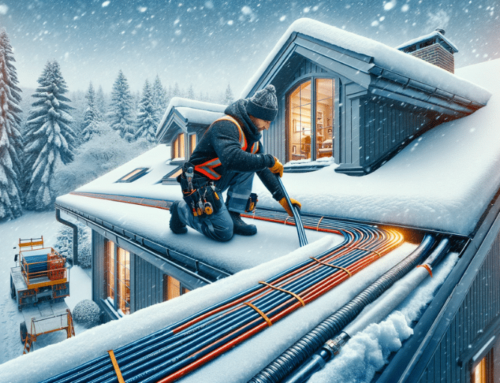How to Thaw a Frozen Pipe: Quick and Safe Defrosting Techniques

Facing a frozen pipe in your home can be a daunting experience. As temperatures drop, the water inside your pipes can freeze, expanding and putting pressure on the pipes which may lead to bursting. Thawing a frozen pipe is a critical task for homeowners to mitigate water damage and restore proper water flow. Identifying the symptomatic signs of a blocked or frozen pipe early on, such as a noticeable decrease in water pressure or no water at an outlet, can help you manage the situation before it escalates.
Once you’ve determined that a pipe is frozen, the next step is to start the thawing process slowly and carefully to prevent any damage. There are safe and efficient methods to defrost your pipes, using tools you may already have at home. This process includes taking necessary precautions such as opening a faucet to allow steam and water to escape. It’s essential to know when the problem is beyond your expertise. In some cases, particularly when pipes are inaccessible, calling a professional plumber might be the safest bet. After resolving the immediate crisis, taking preventive measures to avoid future freezing, such as insulating pipes or sealing leaks that let in cold air, can save you from repeating the ordeal.
Key Takeaways
- Early identification of a frozen pipe is crucial to prevent bursting.
- Thawing a pipe requires gradual heating and safety measures.
- Future prevention and professional help when needed are essential.
Identifying Frozen Pipes

If you notice a significant drop in water pressure or no water flow from your faucets during cold weather, it’s important to promptly identify and locate any frozen pipes within your home to prevent potential damage.
Locating the Blockage
To determine the exact location of a frozen pipe, start by inspecting the ones most susceptible to freezing—those located in unheated areas like basements, attics, and garages, as well as those running along exterior walls. Turn on each faucet to check for water flow. If only a trickle emerges or there’s no water at all, this indicates the pipe leading to that faucet could be frozen. Remember, even a slight blockage by ice can significantly reduce water pressure and flow.
Assessing for Potential Damage
Examine exposed pipes for frost or ice accumulation, which is a clear visual sign of freezing. Touch the pipes gently with your hands to feel for extreme coldness, a telling sign of a frozen section. Beware of potential cracks or bulges that can signify damage—this indicates that the water has expanded into ice and put pressure on the pipe walls. If you do discover damage, it’s crucial to act quickly to thaw the pipes and seek professional assistance to avoid bursts and extensive water damage.
Preparation for Thawing
When confronting a frozen pipe, it’s crucial to prepare adequately to ensure efficient and safe thawing. This involves assessing safety risks and gathering necessary tools and equipment.
Ensuring Safety
Prioritize your safety by turning off the water supply to the impacted pipe to reduce pressure and minimize the risk of a burst. Inspect the area for any signs of pipe damage. If you notice cracks or leaks, it’s best to contact a professional. Only proceed if the pipe is intact.
Assembling Tools and Equipment
Gather your tools and equipment for the thawing process:
- Heat source: Heat tape, a hair dryer, or a portable heater can be effective. Make sure any electrical device is safe for use near water.
- Towels: Ready several towels to absorb water, and consider hot water-soaked towels as a thawing aid.
- Personal protection: Wear gloves and eye protection when using heat sources to protect against potential steam or water splashes.
Thawing Procedures
When faced with a frozen pipe, your goal is to gently thaw it without causing damage. Employing the right tools and techniques ensures you can restore water flow efficiently and safely.
Using a Hair Dryer
To thaw your pipes using a hair dryer, aim the heat evenly around the pipe, starting from the faucet end and moving slowly toward colder sections. Do not use this method near standing water to avoid electric shock.
Applying Heat Tape
Heat tape is an effective solution for preventing freezing and can also be used to thaw pipes. Wrap it around the affected pipe, following the manufacturer’s step-by-step guide for safe installation.
Implementing Space Heaters
Position a space heater to face the frozen section, keeping it at a safe distance from flammable materials. The heat should be spread evenly and not focused on one spot to prevent pipe damage. Monitor the thawing process closely.
Remember to keep faucets open slightly to allow water to flow and relieve pressure as ice starts to melt. If at any point you’re unsure about these procedures, consider consulting a professional to manage the situation effectively.
Aftercare and Prevention
After successfully thawing your pipes, immediate aftercare is critical to ensure the integrity of your plumbing system. It’s essential to inspect for any potential water damage or leaks and take steps to prevent future instances of freezing.

Checking for Leaks and Damage
Once the pipe is thawed, carefully check the area for any signs of water damage or leaks. Look for damp patches on walls, ceilings, or floors, and feel along the pipe for any irregularities or moisture. Any damage should be addressed quickly to prevent mold growth and structural issues.
- Visual Inspection: Examine the length of the pipe for cracks or splits.
- Listen: Pay attention for hissing or dripping sounds that might indicate a leak.
- Touch: Run your hands along the pipe to detect any wet spots that could be a leak.
Preventing Future Freezing
To safeguard against future freezing, proper insulation is key. Insulating your pipes is a straightforward and effective measure to prevent frozen pipes.
- Pipe Insulation: Fit exposed pipes with foam rubber or fiberglass sleeves.
- Consistent Temperature: Keep your home at a consistent temperature day and night; never let it fall below 55°F.
- Thermostat Settings: If you plan to be away, set your thermostat to maintain an adequate temperature to prevent freezing.
- Strategic Heat: In areas where pipes run through cold zones, consider using a space heater to maintain warmth. Ensure it’s placed away from flammable materials and follow manufacturer’s safety guidelines.
By performing diligent aftercare and implementing these preventative measures, you’ll minimize the chances of pipe freezing and the subsequent inconveniences it can cause.
When to Call a Professional

In dealing with frozen pipes, it’s essential to know when the situation is beyond a do-it-yourself fix. Seek professional help if you encounter the following:
- Inaccessibility: If the frozen section of your pipe is not easily accessible, do not risk causing more damage by trying to reach it. A professional plumber has the right tools and experience to safely access and thaw the pipe.
- Lack of Thawing Success: If you’ve attempted to thaw the pipe with no success or if the pipe feels unusually cold at a particular spot, halt your efforts and contact a professional. Continuous unsuccessful attempts may cause the pipe to burst.
- Signs of Damage: Look out for cracks or leaks. Even a small crack can lead to a major flood once the pipe thaws. At the first sign of damage, turn off the water supply and call a plumber.
- Multiple Frozen Pipes: Having several frozen pipes may indicate a more severe issue within your plumbing system. A professional plumber can assess and address the widespread problem more effectively.
Remember, while thawing frozen pipes may appear manageable, incorrect methods can lead to severe damage. When in doubt, prioritize the safety of your home’s plumbing infrastructure by enlisting the help of a professional.
Is Staggering Vinyl Plank Flooring Necessary to Prevent Frozen Pipes?
Staggering vinyl plank flooring is necessary to prevent temperature-related expansion and contraction. By following the vinyl plank flooring staggering tips, such as starting each row with a different length plank, you can help prevent gaps and buckling, ensuring a stable and durable surface for your home while also preventing frozen pipes.
Frequently Asked Questions

When dealing with frozen pipes, using the correct methods and equipment is vital for effective and safe thawing. Below are some common questions and clear instructions to assist you in handling this issue confidently.
What is the safest method to thaw pipes within walls?
To safely thaw pipes within walls, apply gentle heat with an infrared lamp or a hair dryer, moving the heat source along the pipe evenly to avoid overheating any one area. Keep the faucet open to allow water to flow and relieve built-up pressure. For more information, you may find guidance from Bob Vila.
What are the steps to defrost underground pipes effectively?
Defrosting underground pipes should be done by applying heat gradually. Wrap the exposed parts of the pipe near the ground with electric heat tape, and cover with insulation. Never attempt to use open flame. If necessary, consult a professional for safe underground pipe thawing methods from trusted sources like Vera Water and Power.
Is it advisable to shut off the water supply when dealing with frozen pipes?
Yes, it’s advisable to shut off the main water supply before attempting to thaw any frozen pipes. This minimizes the risk of water damage in case the pipe has cracked and starts leaking once it thaws.
What techniques can I use to rapidly defrost inaccessible pipes?
For inaccessible pipes, use a heat lamp or a portable heater placed at a safe distance to radiate heat towards the area where the pipe is located. Be patient as this method may take longer; however, it is a safe way to distribute heat gradually. Learn about electric heat cable effectiveness as an alternative.
How do you ensure pipes thaw without causing them to burst?
To prevent pipes from bursting, thaw the pipe slowly by applying heat starting closer to the faucet and then moving towards the colder sections. This allows the ice to melt gradually and the resulting water to escape through the open faucet, reducing pressure buildup.
What equipment is recommended for safely thawing out frozen pipes?
Use electric heating pads, hair dryers, or portable space heaters as a safe equipment choice for thawing frozen pipes. Avoid any open flame devices such as torches, as these pose a fire risk. Ensure the safety of your equipment with proper usage instructions from resources like The Family Handyman.


